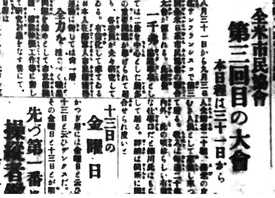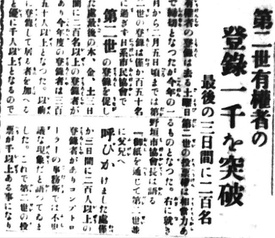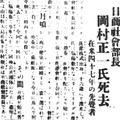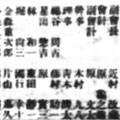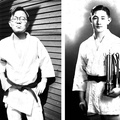In the last chapter, I wrote about the university that Nisei attended. In this chapter, I would like to focus on the Japanese American Citizens League where Nisei actively got involved in politics.
As their Nisei children grew older, the Issei parents expected the Nisei, who had the U.S. citizenship, to get involved in political activities. In September 1921, the North American Japanese Committee held a general meeting for establishing the Japanese American Citizens League where 13 Nikkei citizens with the voting right—males over the age 17 and females over 25—attended, and founded the Seattle Innovative Alliance.
This alliance called out to Nisei across the country to meet up in Seattle, and in 1929, the Japanese American Citizens League (JACL) was founded as a national organization. In 1930, Nisei from different parts of America gathered in Seattle, and the first JACL national convention was held.
JACL National Convention
I found articles that reported the third and fifth JACL national conventions which took place in 1934 and 1938, respectively.
《The Third Convention》
“Third JACL National Convention” (July 12, 1934 issue1)
The third JACL National Convention will be held in San Francisco from August 31 to September 3. With the expense of 1,000 dollars, a number of important issues mostly surrounding the life of Nisei are listed as discussion topics, and each member is looking into them. In regard to the movement for obtaining citizenship of Japanese reservists, which seems to be getting closer to becoming a reality, a specific discussion is expected to happen focusing on citizenship and related issues such as employment to further accelerate its progress.
“Send-off Party for Participants of the JACL Convention” (August 23, 1934 issue)
As the first group from this area, four members (names listed) have already left for the convention. Nikkei’s recent advancement in society has expanded significantly into the political field as well, and we can see some instances, such as the movement on solving the citizenship issue for returning Asian soldiers and on the anti-Japanese problem; and in our vicinity there are such cases as Arai getting into politics.
Since their participation in the convention will be of equal significance, The Great Northern Daily News and The North American Times together decided to throw a send-off party at the Gyokkoken restaurant. The fee is 50 cents. The second group of participants includes Takeo Nogaki, Yoshinori Sakamoto and seven others (names listed).
Seiya Arai listed above ran for Seattle City Council from District 37 and fought well in the election, which was reported in the August 25 issue of the same year. Also, Yoshinori Sakamoto, according to some sources, was a Seattle-born Nisei who worked to convince others across the country of the need of the JACL, playing a key role in its establishment. In 1936, he became the fifth chairperson.
“Sending the JACL Convention Participants” (August 25, 1934 issue)
The send-off party was held last night and was well attended. Arima from the headquarters made an opening speech, and Takabatake introduced each participant after dinner, followed by President Kawajiri from Taihoku (The Great Northern Daily News) who gave a send-off speech. From the representative side, Takeo Nogaki and Yoshinori Sakamoto argued the mission of Nisei, and the party ended in great excitement, with Heiji Okuda giving some words of encouragement. We haven’t had such a promising party in a while.
《The Fifth Convention》
“Nisei Expanding into American Society” (September 3, 1938 issue)
The fifth JACL national convention was held yesterday on the 2nd at the LA Times Auditorium. With Sugawara as master of ceremony, mayor of Los Angeles, Lieutenant Governor of California, the manager of the Los Angeles branch Matsumoto and others each gave a welcome speech, followed by JACL chairperson Sakamoto’s acknowledgement. The convention was concluded by Walter Norge from Union Terminal making a speech titled “The Future of Nisei.”
“As Nisei, you have to do the right thing in the American society. You should attend luncheons and dinner parties of organizations like Rotary Club and interact with Americans; women should attend bridge parties and other social gatherings. I’m certain that Americans will welcome you all. If I could, I would take you all and travel around the country to let everyone know how upright and virtuous of citizens the descendants of Japanese are growing up to be,’ he said, cheering on Nisei.”
On the Problem of Nisei Not Exercising Suffrage
There was a problem: many of the Nisei with the US citizenship did not exercise their voting rights. I found some articles reporting the JACL’s effort to help solve this issue.
“Nonchalant Nikkei Citizens in Voter Registration” (August 22, 1934 issue)
It’s almost noon on Saturday as the voter registration deadline is approaching, yet the fellow Nisei are vastly nonchalant, making the staff members in the office wonder why the Japanese do not register. Nikkei citizens exercise their citizenship mostly when they return to Japan or when they lease land and tend not to use the crucial one that is their voting rights. The rights of those citizens who are not on the voters list will be significantly limited, including jury service.
“Candidates Call Out to Nisei Voters” (February 17, 1938 issue)
As the number of Nikkei citizens with suffrage increases every year, their position in politics is becoming important, and political candidates are calling out to those Nikkei citizens in hope of getting their votes. To take this opportunity to highlight the presence of Nikkei citizens, the JACL will invite four to five candidates to the Nissho Hall at 8 p.m. tomorrow, including the mayoral candidate Doore and the candidate for city council Bowell to hear their political opinions. The JACL is eagerly hoping that many Issei will be there to give a strong impression of the political power that Nikkei citizens have.
President of The North American Times Sumiyoshi Arima commented on the suffrage of Nisei in “Hokubei Shunjyu” as follows.
“On Exercising Suffrage by Nisei” (March 4, 1938 issue)
“What percentage of Nikkei Nisei citizens exercised their voting rights in the last city council election? We cannot get the number, of course, but I don’t think it was high. This is a problem. We need them to think more seriously about this. I understand that many of the Nisei have just reached the voting age and thus have little interest in politics, but they need to be aware of their distinctive role. When they do understand their distinctive role, the exercise of suffrage becomes extremely important to them. To discard such an important right means that they do not understand their position and role. . . .
What Issei had been struggling for and holding onto as their only hope to this day was Nisei’s citizenship. When Nisei do get to use their citizenship, the stigma of Issei’s impossible naturalization will eventually disappear, and they hoped that the legitimate rights for the Japanese in America would be granted then. . . . If exercised well, the position of Nisei will no doubt improve and their relationship with American society will be closer and better. . . .
It is greatly disappointing that while always showing much passion in leisure activities such as dance and skating, Nisei are nonchalant to the exercise of this privileged right. We strongly hope that you the senior Nisei along with the JACL will strive to awaken them to improve this situation.
Under these circumstances, the JACL quickly began promoting the exercise of suffrage by Nisei.
“Nisei Shall Register and Exercise Their Rights” (February 5, 1940 issue)
While the JACL has been urging Nisei to register since before, the Treaty of Amity and Commerce between Japan and the United States became ineffective, and Nisei’s suffrage is crucial in sustaining the rights already earned by the Japanese in the U.S.; chairperson Nogaki thus made the following comment, expressing his wish that those between the ages 21 and 25 would all register.
“We estimate that there are more than 1200 Nisei in Seattle City and more than 2,000 in King County, who are over the age 21, yet the percentage of those with voting rights is low. . . . I will make a list of Nisei with voting rights and talk with politicians with the list if and when a problem arises.”
The estimated population of Seattle-born Nisei (See: Chapter 13) who were over the age 21 as of 1940 was about 1,500.
“Nisei’s Voter Registration Reaches 1,000” (February 13, 1940 issue)
The voter registration was due last Saturday, and the number of Nisei who registered from January this year to around February 5 was only 150. With the JACL urging Nisei to register, over 200 registered in the last three days, making the number of registers go up to over 350. If we add those who had already registered before, the numbers add up to a little over 1,000. The voting rights of Nisei have now come to hold substantial power.
“The JACL Invites City Council Candidates” (February 15, 1940 issue)
The JACL will hold a social gathering tomorrow evening at the newly built hall on 517 Main Street and invite city mayor and candidates for the city council election and others. They look for Nisei’s participation, regardless of whether they are members or not, in the gathering, and their parents are hoping the same as well.
Note:
1. All article excerpts are from The North American Times unless noted otherwise.
*The English version of this series is a collaboration between Discover Nikkei and The North American Post, Seattle’s bilingual community newspaper. This article was originally publishd in Japanese on July 3, 2022 in The North American Post.
© 2022 Ikuo Shinmasu


